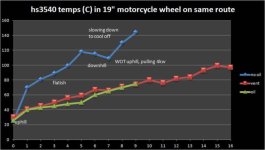Sancho's Horse
1 kW
Strike that, chlorinated and non-chlorinated brake cleaner both create corrosive byproducts when combined with oil.
My feeling is that this technique would be far more successful if the oil is moved out of the motor to convect heat.
Does the necessity of replacing bearings move this strategy to this more intensive and rarified plateau?
John in CR makes good points about simpler air displacement strategies (although ineffective, poorly designed hole drilling patterns reflecting zero understanding of modifying air flow will greatly outnumber examples of good execution). Has anyone started a "hole repair" thread?
My feeling is that this technique would be far more successful if the oil is moved out of the motor to convect heat.
Does the necessity of replacing bearings move this strategy to this more intensive and rarified plateau?
John in CR makes good points about simpler air displacement strategies (although ineffective, poorly designed hole drilling patterns reflecting zero understanding of modifying air flow will greatly outnumber examples of good execution). Has anyone started a "hole repair" thread?



